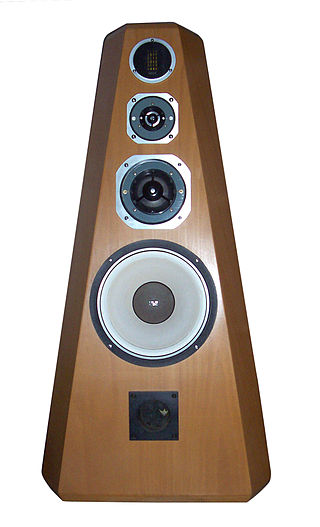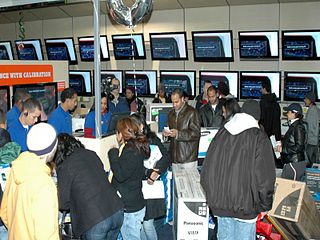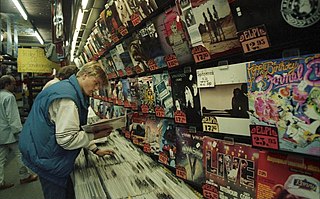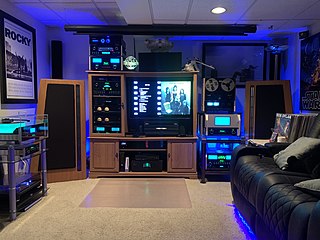
High fidelity is the high-quality reproduction of sound. It is popular with audiophiles and home audio enthusiasts. Ideally, high-fidelity equipment has inaudible noise and distortion, and a flat frequency response within the human hearing range.

Consumer electronics or home electronics are electronic equipment intended for everyday use, typically in private homes. Consumer electronics include devices used for entertainment, communications and recreation. Usually referred to as black goods due to many products being housed in black or dark casings. This term is used to distinguish them from "white goods" which are meant for housekeeping tasks, such as washing machines and refrigerators, although nowadays, these would be considered black goods, some of these being connected to the Internet. In British English, they are often called brown goods by producers and sellers. In the 2010s, this distinction is absent in large big box consumer electronics stores, which sell entertainment, communication and home office devices, light fixtures and appliances, including the bathroom type.

Best Buy Co. Inc. is an American multinational consumer electronics retailer headquartered in Richfield, Minnesota. Originally founded by Richard M. Schulze and James Wheeler in 1966 as an audio specialty store called Sound of Music, it was rebranded under its current name with an emphasis on consumer electronics in 1983.

Western Auto Supply Company—known more widely as Western Auto—was a specialty retail chain of stores that supplied automobile parts and accessories. It operated approximately 1200 stores across the United States. It was started in 1909 in Kansas City, Missouri, by George Pepperdine and Don Abnor Davis. Pepperdine later founded Pepperdine University. Western Auto was bought by Beneficial Corporation in 1961; Western Auto's management led a leveraged buyout in 1985, leading three years later to a sale to Sears. Sears sold most of the company to Advance Auto Parts in 1998, and by 2003, the resulting merger had led to the end of the Western Auto brand and its product distribution network.

Circuit City Corporation, Inc., formerly Circuit City Stores, Inc., was an American consumer electronics retail company, which was founded in 1949 by Samuel Wurtzel as the Wards Company, operated stores across the United States, and pioneered the electronics superstore format in the 1970s. After multiple purchases and a successful run on the NYSE, it changed its name to Circuit City Stores Inc.
Lafayette Radio Electronics Corporation was an American radio and electronics manufacturer and retailer from approximately 1931 to 1981, headquartered in Syosset, New York, a Long Island suburb of New York City. The company sold radio sets, Amateur radio (Ham) equipment, citizens band (CB) radios and related communications equipment, electronic components, microphones, public address systems, and tools through their company owned and branded chain of retail outlets and by mail-order.
Durabrand is a private label tradename of Walmart, which was introduced in early 1999. It was previously available in the UK through ASDA as a replacement for the Pacific brand name.
Emerson Radio Corporation is one of the United States' largest volume consumer electronics distributors and has a recognized trademark in continuous use since 1912. The company designs, markets, and licenses many product lines worldwide, including products sold, and sometimes licensed, under the brand name G Clef, an homage to Emerson's logo.
Harman Kardon is a division of US-based Harman International Industries, an independent subsidiary of Samsung Electronics. Harman Kardon was originally founded in Westbury, New York, in 1953 by business partners Sidney Harman and Bernard Kardon.
Denon is a Japanese electronics company dealing with audio equipment. The Denon brand came from a merger of Denki Onkyo and others in 1939, but it originally started as Nippon Chikuonki Shoukai in 1910 by Frederick Whitney Horn, an American entrepreneur.

JB Hi-Fi Limited is an Australian consumer electronics and home appliances retail company. It is publicly listed on the Australian Securities Exchange. Its headquarters are located in Southbank, Melbourne, Victoria.

Silo was an electronics retailer operated throughout the United States between 1947 and 1995. The western region stores were known for a number of years as "Downings" in Colorado and "Appliance-TV City" in Arizona and California.

A record shop or record store is a retail outlet that sells recorded music. In the late 19th century and the early 20th century, record shops only sold gramophone records, but over the 20th century, record shops sold the new formats that were developed, such as eight track tapes, compact cassettes and compact discs (CDs). Today in the 21st century, record stores sell CDs, vinyl records and in some cases, DVDs of movies, TV shows, cartoons and concerts. Some record stores also sell music-related items such as posters of bands or singers, -related clothing items and even merchandise such as bags and coffee mugs.
Krazy Krazy Audio Video Warehouse was a Canadian retailer of consumer audiovisual electronics. In operation from 1983 to 2009, the chain began to decline in the late 1990s and 2000s due to the changing consumer electronics market. Although no longer operating as a national chain, a few former franchise locations remain in business as independently operated local stores.
Luxman is a brand name of Japanese Luxman Corporation (ラックスマン株式会社) that manufactures luxury audio components. Luxman produces a variety of high-end audio products, including turntables, amplifiers, receivers, tape decks, CD players and speakers.

Tweeter, formerly Tweeter Etc. and Tweeter Home Entertainment, was a specialty consumer electronics retailer providing mid and high end electronic equipment, including flat panel TVs, plasma TVs, car radios, home theater systems, GPSs and more. It also focused much of its business on custom installation of electronics for homes and automobiles.

Home audio systems refer to audio consumer electronics designed for home entertainment, such as integrated systems like shelf stereos and music centers, as well as individual components like loudspeakers and surround sound receivers. The evolution of home audio began with Edison's phonograph, transitioning from monaural to stereophonic sound in the 1950s and 60s. The term "hi-fi" emerged, highlighting sound accuracy and minimal distortion. Audio equipment evolved from large wooden cabinets to compact units. The 1970s introduced enhancements like quadraphonic sound and technologies like Dolby Pro Logic. The 1970s and 1980s also saw the rise of component-based stereo systems. Cassette decks became a staple in the 1970s. Integrated systems, termed "music centers" gained popularity in the 1980s. Table systems and compact radio receivers emerged as entertainment devices, with some offering features like cassette players and CD functionalities. Audiophile systems prioritize high-quality music formats and specialized equipment like premium turntables, digital-to-analog converters, and other high-end devices, with some enthusiasts preferring the unique sound characteristics of vinyl records and vacuum tubes. Modern systems often emphasize home cinema applications to enhance the audio experience beyond standard TV speakers.
Audio Advice, Inc. is a specialty consumer electronics retailer in the United States, specializing in home and portable audio, home theater, and smart home technology. Audio Advice operates as both a retailer and custom systems installer/integrator with branches in Raleigh, North Carolina and Charlotte, North Carolina.
















